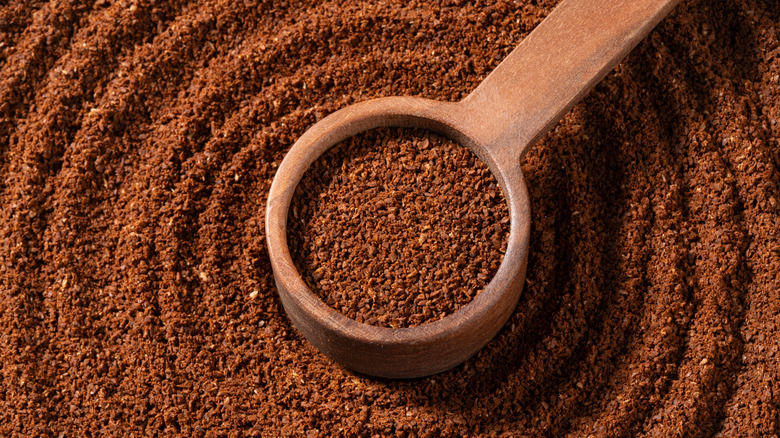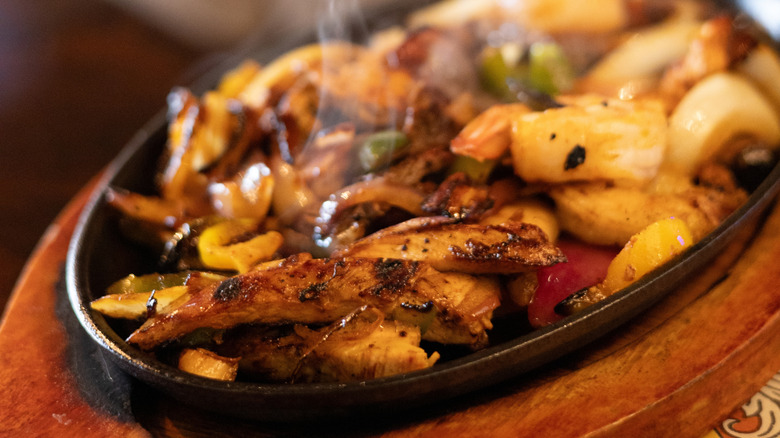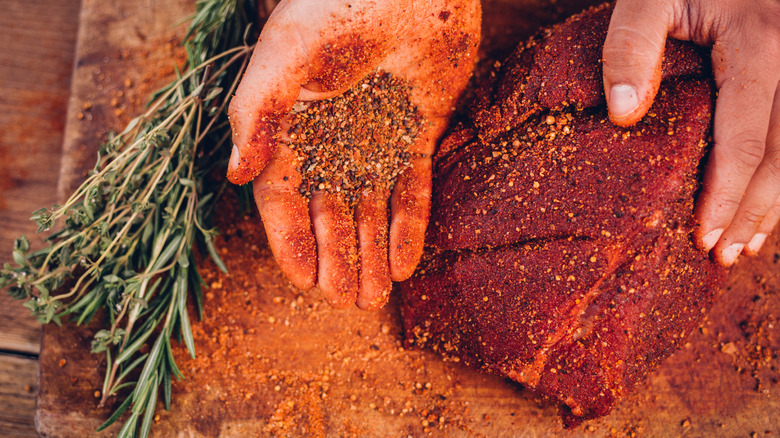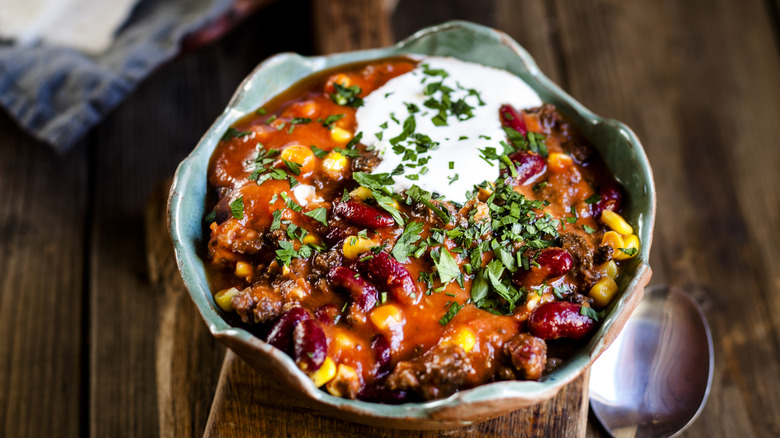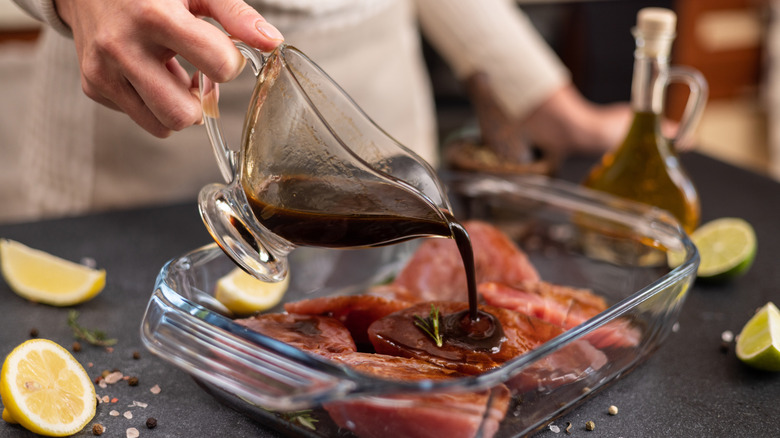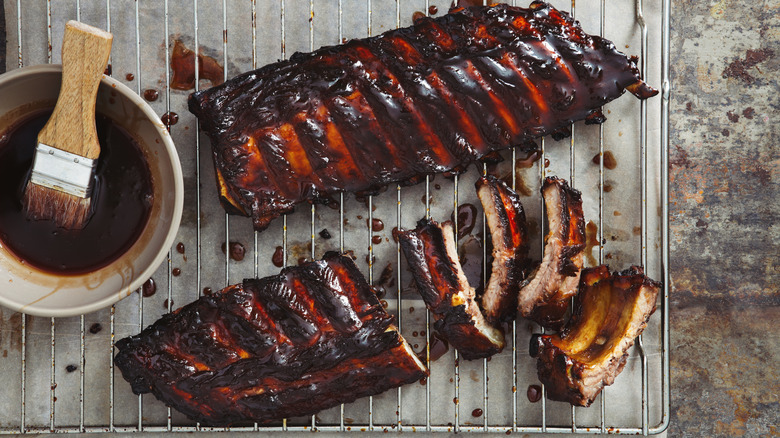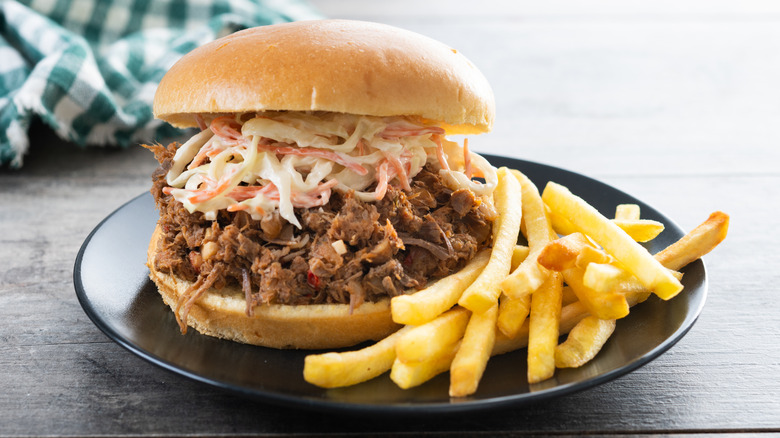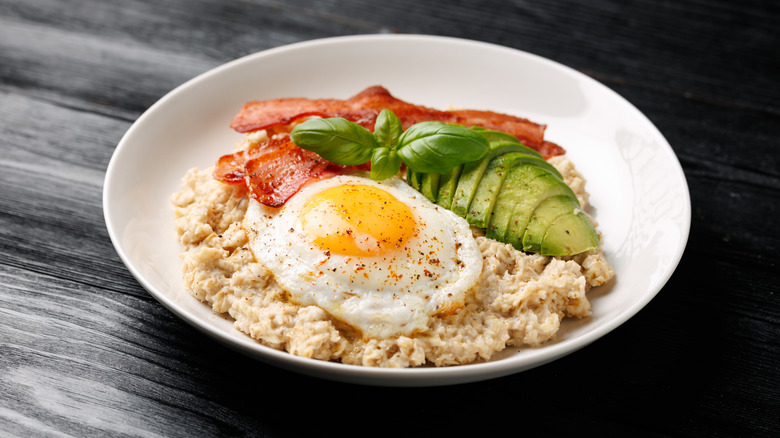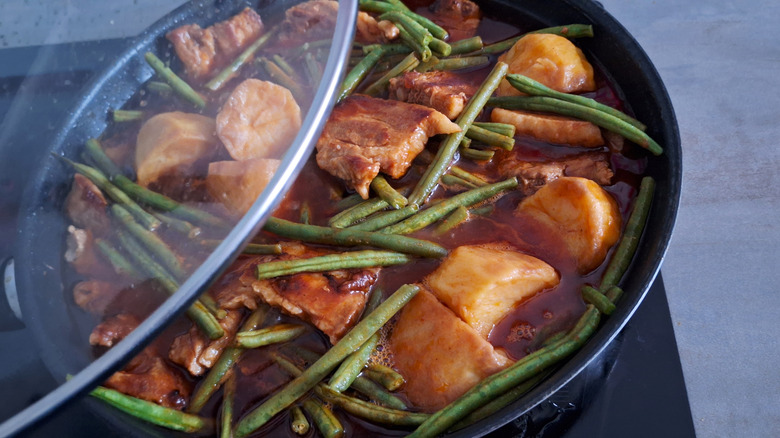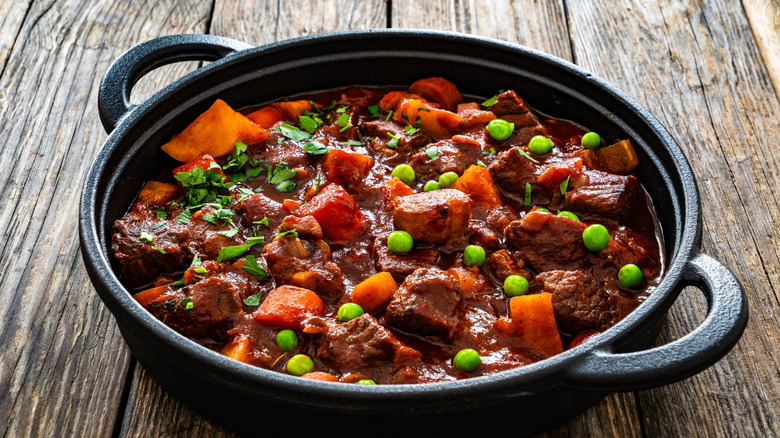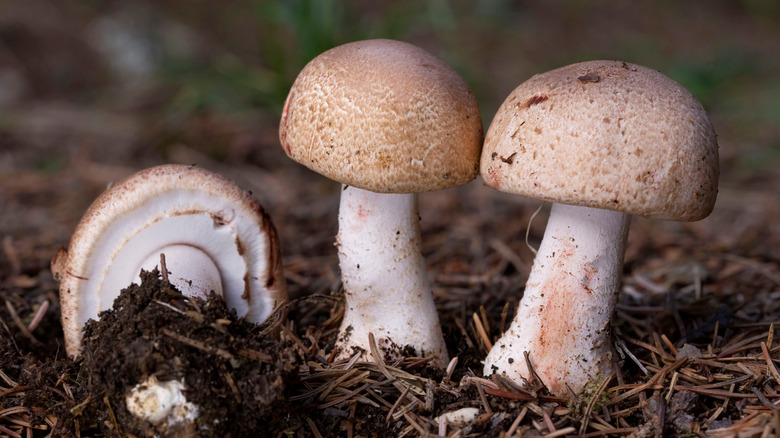10 Savory Uses For Ground Coffee
Wondering what to do with your coffee beans other than making a pot to get you going in the morning? In addition to brewing a tasty cup of joe, ground coffee can be used in plenty of savory ways in your kitchen. Coffee dates back to around 800 AD, when it was "accidentally" discovered to be an energizing and tasty substance. While the exact origins remain a mystery, we can be sure that its uses today go beyond a simple beverage.
Most of us are more familiar with using coffee to add depth to desserts (creamy hazelnut tiramisu, anyone?) but it also pairs well with meat, soups, and stews. The gritty grounds work as a meat tenderizer and can be added to everything from rubs and marinades to beyond. Texture is always a consideration, so think about whether you want to embrace a grainier consistency with coarse grounds or something smooth with brewed coffee. When adding flavor with coffee grounds, remember that this ingredient can be bitter and even acidic, which makes it a natural partner for sweet and bright ingredients.
In some cases, you'll want to use fresh grounds for a recipe or to brew a cup to then incorporate into your cooking. But that doesn't mean that used grounds are completely useless. The leftover element of your morning cup is the perfect addition to your garden to grow new ingredients.
1. Add flavor to fajitas
Fajitas can hold up to plenty of flavor, including from a ground coffee marinade. Add a small scoop to a simple base of olive oil, vinegar, salt, and pepper. Elements like brown sugar, garlic powder, and chili powder boost the marinade even more. Alternatively, brew a little extra coffee in the morning and stir it right into the mix, cutting down on waste while enhancing the taste.
You don't need a lot of extra tools and equipment to add coffee grounds to your dish. Stick with a simple one-pan chicken fajitas recipe that combines onions, bell peppers, and marinated chicken for a meal that hits your protein and nutrient needs. Plus, adding coffee grounds to your marinade starts the tenderizing process, giving you juicy results with bite-size bursts of flavor as you eat.
Skillet fajitas are also easy to prepare on the stove; just be sure to get your pan piping hot for the best results. Cut your meat into strips before you marinate so that every bit gets coated with flavor. Put them right on the hot pan and let them develop a savory crust on the outside. You can even serve them in a sizzling skillet for an impressive presentation.
2. Make a rub
Ground coffee is a fantastic ingredient to include in a dry rub for any type of meat. Just add the grounds to your steak or chicken beforehand for a boost of savory flavor, and consider mixing in other spices and seasonings. The deep, rich flavor of coffee works well on steak, especially if you plan to grill it and create a crust.
Most people like to use a dry rub to tenderize the meat as well as add flavor. The right way to use a dry rub depends on when you plan to apply it. You can put a thin layer on the meat before searing, or add it after the fact to reduce the chance it will burn. Dry rubs that contain sugar can easily burn on a hot grill, so it's best to sear the exterior first, then add the dry rub. Finish it off by placing the steak back on the heat at a lower temperature.
If you omit the sugar, you can apply the dry rub in a thin layer to the steak after patting it dry with a paper towel. Some people choose to work with a binder, such as olive oil, which helps the dry rub stick to the meat.
3. Add it to chili
Want to transform a basic chili recipe into something wow-worthy? Coffee makes a fantastic secret ingredient to upgrade your chili beyond the classic version that people eat all the time. It melds well with the other ingredients to bring more depth without standing out too boldly. Your guests will be left guessing how you made each bowl extra hearty and savory.
A little bit of coffee in your chili mix will enhance the taste of the other ingredients. It works well with the spice from the chili powder, giving it an oomph behind the heat without making it too spicy. Chili loaded with acidic tomatoes also benefits from the bitterness of coffee. The two ingredients work well together to build a balanced flavor.
Keep a lighter hand when incorporating coffee into chili because you only want it as an accompaniment rather than a dominant flavor. You can stick with brewed coffee or use instant coffee powder for this purpose. If you're adding coffee grounds, use them with the broth base and filter out the residue before mixing in the rest of the ingredients. You might need to adjust the amount of other liquids in the pot to keep the chili from becoming too soupy. If you need to thicken it after adding the coffee, just let it simmer on the stove, which will also concentrate the taste.
4. Use it as a meat marinade
It's not a secret that a great marinade can make any cut of meat more flavorful and tender, but incorporating a little bit of coffee into it is a method that people may not expect. It works with steak, of course, but the bitter compounds in coffee also help tenderize chicken, turkey, pork, and just about any other meat.
Add some of your leftover morning brew or a spoonful of grounds to a simple marinade of olive oil and spices for additional flavor and tenderness. You can also use brewed coffee or instant powder for quick results, even with tougher cuts like brisket or chuck. Make sure to thoroughly mix the marinade together before adding it to the meat so that all of the flavors are incorporated. Unless you go really heavy on the grounds, the final dish won't have a strong coffee taste, but will benefit from the deep richness of coffee.
When you marinate meat with acidic ingredients like ground coffee, the proteins begin to break down as the bonds between the cells weaken. Once you put that steak or chicken on the grill, the meat is already looser at the cellular level and you get to enjoy a super tender dish.
5. Make barbecue sauce
Savory, sweet, tangy. No matter how you like it, barbecue sauce makes an excellent addition to meat and roasted vegetables. It adds a distinct flavor that stands out even more with the addition of grounds or brewed coffee, which give barbecue a robust flavor. Coffee pairs best with tomato-based barbecue sauces, such as a traditional Kansas City style which also includes molasses and plenty of spices. The acid from the tomatoes complements the bitter coffee and sweet molasses for a balanced sauce that can hold its own with thick meaty cuts like brisket, pulled pork, and ribs.
Add a little bit of coffee to the cooking process to get a uniquely deep flavor that you can use with any type of meat. Grilling and smoking take it to the next level, bringing in more flavor for an even richer taste. An alternative method includes adding coffee or grounds to a grilling plank or soaking smoking chips in freshly brewed coffee for a subtle flavor.
You can add a little bit of grounds to a store-bought barbecue sauce, simmering everything on the stove to meld the flavors together. Just make sure to strain out any gritty bits from the final sauce. If you prefer to try your own homemade barbecue sauce, adding coffee lets you customize the final taste.
6. Enhance pork
Pork is packed with flavor on its own, but adding a little bit of ground coffee takes this main dish to the next level. Use it as a savory rub or a marinade for a pork shoulder before popping the meat in a slow cooker, along with ground coffee, onions, garlic, and chicken broth. You can adjust the amount of broth used if you substitute brewed coffee instead. Meanwhile, add-ins like brown sugar infuse sweetness, while chili powder, cumin, and a dash of cinnamon bring heat and depth. Pair the resulting pulled pork with a coffee-infused barbecue sauce for a truly tasty dish.
When using coffee grounds to enhance the flavor of pork, it's important to note that this type of meat is saltier than average. You likely won't need to add much salt to your rub or marinade, as the bitterness of the coffee will help balance the other elements. Like with other marinades and rubs, coffee helps break down the protein fibers in meat. For pulled pork, which is cooked low and slow for the best results, this pre-tenderizing step makes it even more delectable. You can use a similar recipe and method for pulled chicken or beef, adjusting the cooking time to account for various sizes.
7. Swap out savory oatmeal
When you think of oatmeal, chances are sweeter additions like brown sugar, fresh fruit, and raisins come to mind. But oatmeal doesn't have to be a sweet dish. You can add savory elements such as nuts, greens, mushrooms, and even meat to turn this breakfast powerhouse into a satisfying and nutrient-rich meal to start your day. Coffee grounds provide a deep flavor plus a jolt of caffeine at breakfast time.
Just be sure to adjust the amount of liquid you use, especially if you're adding a cup of brew rather than grounds. Messing up the liquid to oat ratio is one of the most common oatmeal mistakes, creating a soupy mess rather than a thick, savory dish. Substitute coffee for water in a one-to-one ratio, but don't go all-in on the coffee for a balanced bowl.
The coffee flavor will be more prominent in oatmeal than with other dishes on this list, because oatmeal serves as a nice base but doesn't bring in a ton of flavor on its own. Other savory ingredients like mushrooms, sauteed greens, and even spicy chili crisp help turn a boring breakfast into a show stopper that will fuel you up to start the day. Top it with a fried egg and bacon to create breakfast-in-a-bowl, complete with your morning cup of joe.
8. Braise tough meat
Coffee acts as a tenderizer while also adding liquid when used as a braise. The slow and low cooking process helps keep tougher cuts of meat tender, while still bringing in plenty of flavor characteristic of high-heat searing. Braising needs plenty of liquid, which is where coffee comes into the picture. You can add the grounds to hot broth or use leftover coffee. Braising works for both meat and vegetables, which means a one-pot dinner with less cleanup.
There are two methods of braising and the best one for your dish depends on the final consistency you want. For a short braise, keep the meat on the heat for just enough time for it to reach the desired doneness. This method is perfect if you want to keep the inside a little bit more pink and ensure vegetables maintain a hint of their crunchy bite.
If you prefer super tender meat and an almost stew-like consistency, go with a long braise. With this method, all of the collagen in the meat breaks down completely and the vegetables get super soft. The result is meat that practically melts in your mouth and vegetables that get tons of flavor from the braise. You can serve them together over mashed potatoes for an easy dinner that is super satisfying.
9. Stir it into stew
Coffee is one of those secret ingredients that can give your beef stew a little boost of flavor. While this cold weather favorite is hearty as is, stirring in a bit of your leftover brew from the morning can make it even better. You don't need a lot to deepen the flavor of your beef stew, so don't overdo it. Start with a tablespoon or two, then let the ingredients simmer together. Taste often to adjust for your preference.
The grittiness of grounds on their own don't work well in most stews, however, so it's best to use them to brew a cup before adding the liquid to the stew pot. Complementary elements that you can pair with coffee include umami rich mushrooms or bright herbs. These all work together to create a deeper and more complex stew that will quickly become your go-to recipe.
If you use a lot of sweeter ingredients, like caramelized onions and carrots, the bitter bite of coffee also provides some balance. Be sure to use coffee without sweeteners or milk; black coffee combines with broth to form a deliciously rich and savory base. You can substitute it one-to-one for part of your broth, but avoid fully swapping out coffee for the other liquids or the bitter taste will take over.
10. Grow mushrooms
No, we're not talking about mushroom coffee (although it does make a great coffee alternative). This trick relies on used grounds as a base for growing mushrooms. Instead of getting flavor from the coffee, you can grow mushrooms using it as a substrate, then add your own harvest to your cooking. Mushrooms at the store can be pricey, especially if you want to incorporate more exotic types.
This is one of the many ways to repurpose coffee grounds that can have a direct impact not just on your cooking but also on your budget. Rather than spending money on quality soils or fertilizers, use what you already have after brewing your morning cup. This also cuts down on household waste that might end up in a landfill.
It's best to stick with mushrooms that you purposefully grow in your garden rather than eating random mushrooms that pop up in your yard. Unless you are a fungi expert, it can be difficult to distinguish between the edible varieties and those that can cause illness or even death. Set up a mushroom growing area with coffee grounds as a substrate to let your edible fungi harvest flourish. You'll be able to use your mushrooms as a savory meat substitute or to add umami to existing recipes.
